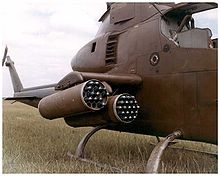Hydra (rocket)

The Hydra 70 is an American unguided air-to-surface missile , it is fired from attack helicopters or combat aircraft .
The Hydra 70 is a further development of the FFAR rocket ( F olding F in A erial R ocket , in German rocket with fold-out stabilizers ). Both models have three fold-out aluminum tail fins for flight stabilization; hence the type designation WA or WAFFAR ( W rap A round F olding F in A erial R ocket, in German rocket with wrapped fold-out stabilizers ) of the original model.
Multiple start containers of various sizes are used. The missile is powered by a Mk-66 solid rocket motor.
Different Hydra versions have been developed around the world, all of which are 70 mm in diameter:
- Ares, Brazil
- Avibras, Brazil
- CRV7 , Canada
- Forges de Zeebrugge , Belgium
- Hanwha, South Korea
Depending on the warhead used, they can be used both to fight hard targets (e.g. anti-tank defense ) and against people ( soft targets ).
history
Originally developed in the Second World War to combat bomber formations with fighter planes , FFAR were increasingly used in ground combat support towards the end of the war . In the development of the armed helicopter at the time of the Vietnam War , they represented a suitable way of deploying effective fire over a large area with a relatively low weight. This role has been retained in modern attack helicopters and complements the combat against single targets with guided missiles.
Warheads:
- Flechette (1179 pieces, 3.9 g each)
- Splinter blast (HE - H igh E xplosive)
- Multipurpose diffuser
- smoke
- Luminous body
- Training warhead
Advanced Precision Kill Weapon System
The Advanced Precision Kill Weapon System (APKWS) was a development program that was supposed to be compatible with the existing systems of the Hydra 70 and, among other things, was to have a laser-guided warhead. General Dynamics and BAE Systems began developing the first prototypes in 2002. The take-off and flight tests took place at Eglin Air Force Base in Florida . Existing components of the Hydra 70 such as the launch pad, rocket, engine and warhead were used for the system. The weapon should bridge the gap between the systems of the Hydra 70 and the AGM-114 Hellfire , as well as enable cost-effective combat against armored point targets. The entire development program was stopped in April 2005 because it did not meet expectations.
Advanced Precision Kill Weapon System II
After the poor results of the APKWS program, a new specification was issued because the US Army still needed an inexpensive guided missile. This builds on the original APKWS program. Two development teams have been admitted to the competition. The first is made up of the Lockheed Martin and Raytheon companies . BAE Systems, Northrop Grumman and General Dynamics make up the second team. In April 2006, BAE Systems' team was declared the winner and a three-year contract for development and construction was concluded.
Although Lockheed and Raytheon were inferior, both companies are now developing their designs separately. At Lockheed it is called Direct Attack Guided Rocket (DAGR), while at Raytheon it is called Laser Guided Rocket (LGR).
There are several similar systems that are very similar to APKWS I and II, but did not participate in the competition. For example, Elbit Systems and Alliant Techsystems have the Guided Advanced Tactical Rocket-Laser (GATR-L), Magellan Aerospace and Kongsberg Defense & Aerospace have the CRV7 Precision Guided (CRV7-PG), and Forges de Zeebrugge ( Thales Group ) there is the FZ275LGR.
Web links
- Hydra 70 on GlobalSecurity.org (Eng.)
- APKWS on GlobalSecurity.org (Eng.)
- Hydra 70 designation-systems.net (Engl.)
- APKWS and II on deagel.com (Engl.)
